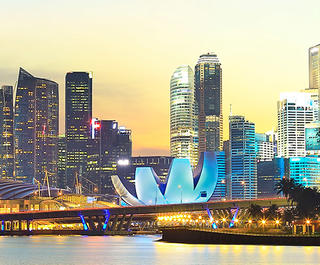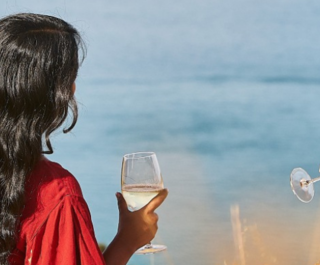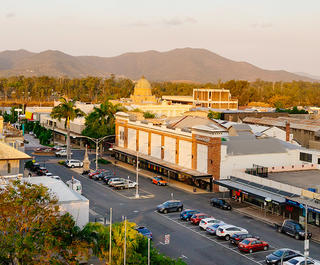
When I first visited Bali in 2006 I did what many tourists do. I went to Kuta, a compression point of hotels, bars, restaurants and malls on the urbanised southwest coast. I ate, I danced, I sunbaked and shopped. I had loads of fun, but at the same time I knew I was doing myself a disservice. For beyond the confines of Kuta is a land with so much natural beauty and such a rich and colourful culture, that it’s known as the ‘island of the gods’.
“There are about 800 different incarnations of Bali – and I love everyone of them,” says James Wilkins, a fine arts photographer from New York living in Bali. “Take a scooter down a path and you discover a new waterfall, a beach, a village, a temple or a shrine. You could spend a lifetime exploring it.”
In the years that have passed, I’ve been back to Bali half a dozen times with the express aim of seeing all 800 of those incarnations. And while I’m not quite there yet, I’ve collected a wealth of information on things to see and do in Bali. Here are some of the highlights organised into three different road trips that will take you beyond the sugar-coated confines of Kuta.
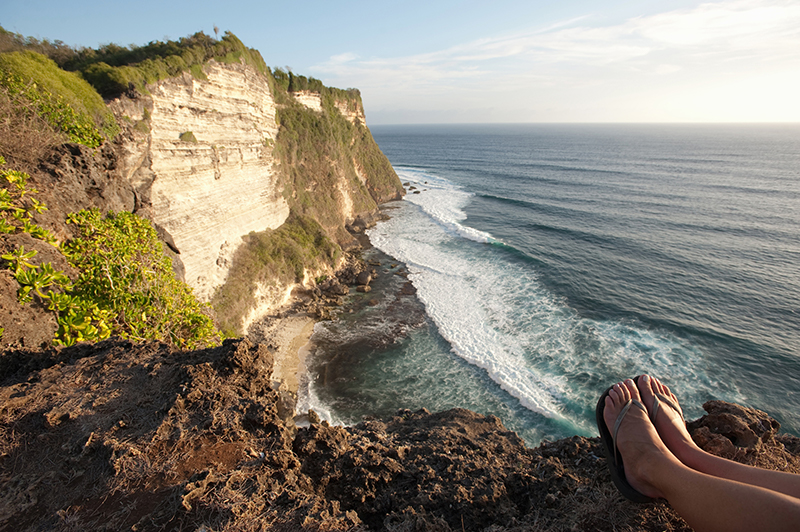 Sit back and take in the views of the stunning Bukit Peninsula. (Image: Getty)
Sit back and take in the views of the stunning Bukit Peninsula. (Image: Getty)THE BUKIT PENINSULA
Going back a decade, the Bukit Peninsula in Bali’s deep south was visited only by surfers who’d make the hour-long pilgrimage from Kuta to ride glassy tubes at Dreamland, Impossible and other secret beaches hidden under steep coastal cliffs. Today it is the number-one escape for expats and holidaymakers looking for a taste of old Bali.
Begin your pilgrimage with a visit to Kedonganan Market, the largest fish market in Bali, set just past the airport on Jimbaran Bay. The best time to see it is at dawn, when fishermen land brightly coloured outriggers on the beach and carry wicker baskets full of snapper, grouper, prawns and other seafood to market.
From Jimbaran Bay continue south, passing the turnoff for Dreamland to Bingin Beach. Bingin is Bali’s new ‘it’ beach where visitors spend the day surfing, exploring the exposed coral reef and relaxing at cliffside eateries overlooking the beach. My favourites are Kelly’s Warung, a juice bar with hostel-type accommodation, and Swamis, which cooks up a succulent seafood barbecue on the beach come nightfall.
The next stop on the road trip is Uluwatu Temple. Perched atop a steep cliff overlooking the Indian Ocean, the views from this 11th-century temple are absolutely gobsmacking. Don’t miss the daily kecak dance performance at 6pm, where 50 performers in traditional garb chant in Hindu while dancing feverishly to a xylophone assembly.
Fifteen minutes’ drive to the east is Karma Kandara Resort, where about AUD$25 buys a ticket on an inclinator leading down to the Karma Beach Club – perfect for families with small children or older folks ill-inclined to walk down the steep limestone walkway leading to the beach. Order a wood-fired pizza, grab a massage, paddle around in the surf, or suntan on the fine white sand.
On the northeast corner of the peninsula is Nusa Dua, with three category-busting attractions that make it well worth a visit: the Pasifika Museum, a treasure trove of art from all over the Asian Pacific region; Bumbu Bali, Bali’s best satay restaurant and best cooking school; and Amanusa, the flagship property of Aman (one of the world’s most prestigious hotel chains) and the most luxurious place to stay in Bali. Think Ben-Hur meets Cleopatra’s palace with pool boys in polo shirts serving Champagne and caviar.
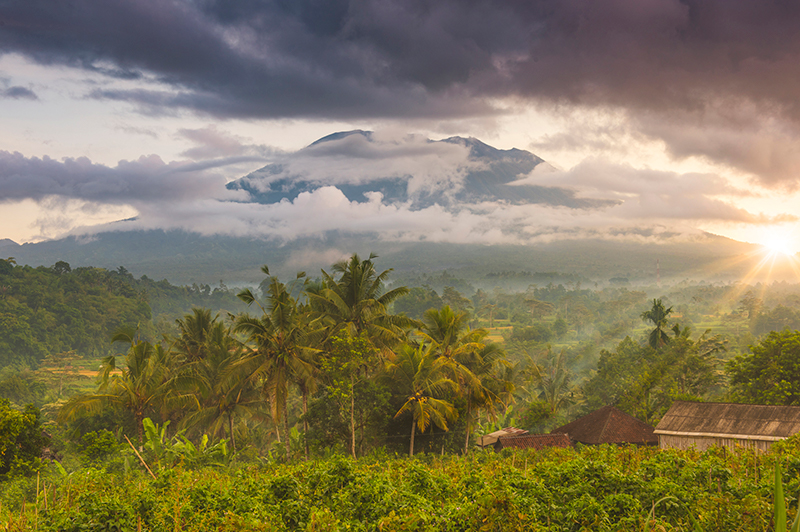 Mount Agung casts a shadow over the lush Sideman Valley. (Image: Getty)
Mount Agung casts a shadow over the lush Sideman Valley. (Image: Getty)Eastern Bali
For our next journey we travel to eastern Bali, where Mount Agung, a volcano revered by the Balinese as the home of the gods, casts a long shadow over the villages and rainforests of the coast in a setting that is the very embodiment of a tropical fantasy.
Starting from the capital Denpasar, follow the coastal road east for two hours to Candidasa. An up-and-coming coastal town, Candidasa has a large range of accommodation options, varying from basic cottages to 5-star villas, including Alila Manggis, where James Wilkins dispenses sunrise photography lessons.
A short drive north of Candidasa is the village of Tenganan, the ancestral home of the indigenous Bali Aga people. The Bali Aga are known for their ‘double ikat’ weaving technique that produces the most beautiful sarongs in all Indonesia – and the fact that any villager who marries an outsider must move out of the village.
East of Candidasa is Pasir Putih, or White Sand Beach, is the stuff that tropical island postcards are made of – a half-moon bay lined with coconut trees and kiosks. Access is restricted by a heavily rutted track or a half-hour boat ride from Candidasa.
Further to the east, near the village of Seraya, is the Ujung Water Palace. Built in 1919 by the last raja of Karangasem, the palace features three large ponds interconnected by footbridges set against the awesome backdrop of Mount Agung. An even larger water palace, Tirta Gangga, lies half an hour to north.
Near the easternmost point of Bali sits Amed, a string of fishing villages reminiscent of Kuta in the 1970s. From bars decorated with seashells and family-run boutique hotels, development is Amed is low-key and locally owned. Rise at dawn to see fleets of outriggers returning to port with their morning catch, or charter one yourself for a spot of fishing or to snorkel over the reef.
For a land-based adventure, set your sights on the summit of Mount Agung. Most people take guided tours that involves a late night pick-up and a pre-dawn climb. Depending where you start the walk, it will take between three and seven hours to reach the peak.
Cap off your tour of the east with a night or two at Sideman, a fairytale-like setting among rice paddies in the geographic heart of eastern Bali. The German painter Walter Spies moved here in the 1930s to escape the commotion of Ubud – a move contemporary travellers have been emulating for years. Spend time hiking, meditating, practising yoga, attending cooking classes, or simply soaking in the gentle rhythms of village life.
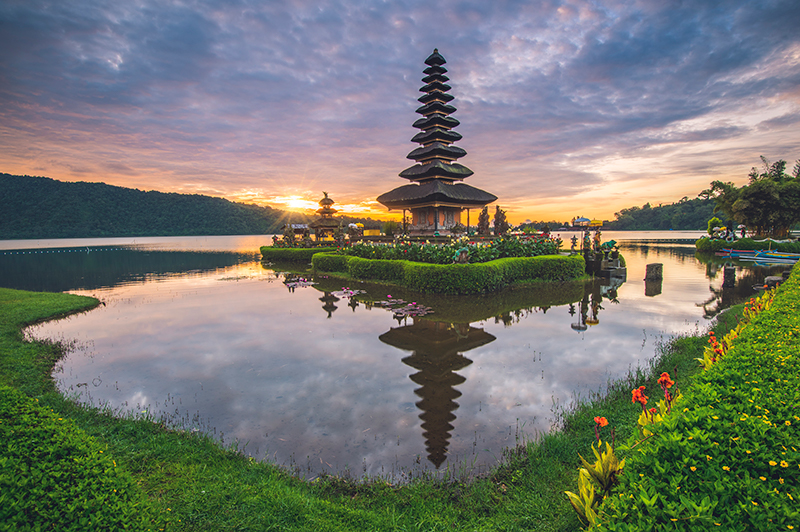 Lose yourself in the dreamy serenity of Puru Ulun Danu Bratan temple in Lake Bratan. (Image: Getty)
Lose yourself in the dreamy serenity of Puru Ulun Danu Bratan temple in Lake Bratan. (Image: Getty)West Bali National Park
It is the least-visited part of Bali but also the most authentic and untouched – and getting there is half the fun. Heading north out of Denpasar, your route to West Bali National Park cuts through the UNESCO-listed rice terraces of central Bali before reaching the dreamy lakes district. To your right is Mount Bratan and Bratan Lake with an 11-storey Hindu temple on its shores, while the twin lakes of Buyan and Tamblingan are seen on the left side of the road. Stop for a swim, a ride on a speedboat, a snack at a fruit stall or to feed the monkeys. But don’t leave your valuables unattended even for a second; Balinese monkeys are expert thieves.
Continuing north, the road curves like a snake into the cool tropical highlands, past coffee and clove plantations, giant banyan trees and bamboo forests, until the turnoff for the highland village of Sambangan.
Park at Shanti Panorama View Hotel and ask one of their guides to take you trekking to the Secret Garden – a lush green gorge sluiced by a holy river and four large waterfalls. The largest waterfall, Aling-Aling, a roaring 35m high, has a natural stone waterslide that drops into a crystal-clear pool.
The following day rejoin the main road and follow it to Singaraja, the colonial capital of Bali, before veering west along the coast. Drive for an hour to the village of Seririt in Bali’s grape-growing district. Nominally sold as table grapes, Seririt grapes are also used to make wine. That’s right... this isn’t a misprint... Balinese wine! Try it for yourself at the Hatten Wines Visitor Welcome Centre, which offers free wine-tasting and vineyard tours from Monday through to Saturday.
From Seririt continue west to Pemuteran, a laidback seaside village and hub for dive centres and resorts. Every morning, boats laden with tourists depart for short cruises to Menjangan Island. The centrepiece of West Bali National Park, Menjangan is surrounded by neon-blue waters and coral reefs bursting with marine life.
Menjangan Island is also home to Gili Kencana, a candy-coloured temple set on limestone rock. There are more Hindu temples on the mainland section of the park, including Melanting, a 15th-century edifice on the foothills of Mount Pulaki, and the Pulaki temple with 360-degree misty mountain views.
You should come to this part of Bali because it’s beautiful, it’s peaceful and it’s untouched,” says Koman Yas Artika of Shanti Panorama View Hotel. “We don’t have bars or nightclubs, but we have peace with nature.”
Beyond Bali
Bali may be the most popular island in Indonesia, but there are 18,305 more islands waiting to be discovered. Here are three little pieces of paradise found in Bali’s backyard.
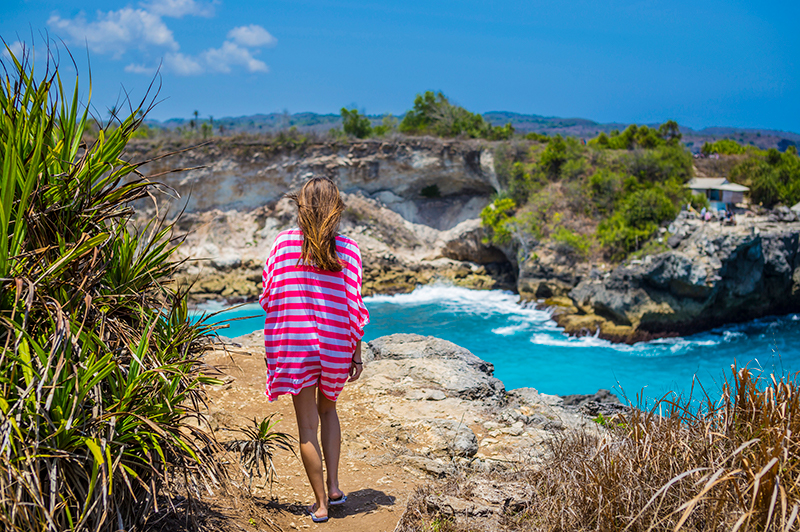 Nusa Lemgongan is fast becoming a haven for surfers and yogis with its enviable backdrop. (Image: Getty)
Nusa Lemgongan is fast becoming a haven for surfers and yogis with its enviable backdrop. (Image: Getty)1. Nusa Lembongan
A 30-minute cruise but a million metaphorical miles away from Bali, Nusa Lembongan is a small island southeast of Bali. It was discovered by surfers about a decade ago and was a backpacker destination to start. But now, Nusa Lembongan is experiencing somewhat of a boom and attracting travellers of all socio-economic types. Surfing, however, remains the major drawcard with three notable offshore breaks: Playground, Lacerations and Shipwrecks. Visitors rarely have to share the waves there or at Secret Point, a massive righthand break on neighbouring island Nusa Ceningan. Nusa Lembongan is also a growing hub for yoga, with studios popping up all over the place, and a hub for diving, following the recent creation of the Nusa Penida Marine Park, a biosphere reserve protecting the waters and reefs surrounding the island.
Why visit now? Nusa Lembongan is one of the best places in the world to scuba dive with oceanic manta rays.
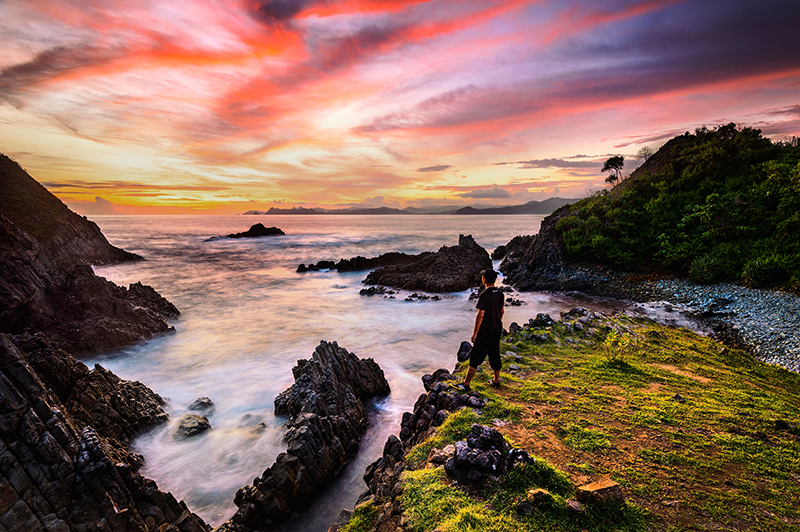 Lombok's Semeti Beach is famous for its rocks shaped like pyramids that jut from the water. (Image: Getty)
Lombok's Semeti Beach is famous for its rocks shaped like pyramids that jut from the water. (Image: Getty)2. Lombok
Imagine Bali sans traffic, hawkers or crowds. Enter Lombok, a volcanic island due west of Bali that’s attracting a slow but steady trail of tourists looking to get off the beaten path. There are a range of ferries and speedboats that will get you there from Bali, and an international airport in Lombok’s south with direct connections from Bali, Jakarta and Singapore. The most visited part of Lombok is Senggigi, a strip of palm-fringed beaches with pockets of small development on the island’s west coast. Lombok also has its own Kuta – a long, empty surfing beach on the south coast with a smattering of well-priced resorts. But to see the best of Lombok, hire a car, motorbike or taxi and explore the island’s centre, a velvet-green cornucopia of valleys, soaring mountains, waterfalls, rice fields, tobacco plantations and hamlets that remain practically untouched by the modern age.
Why visit now? Climb to the rim of Mount Rinjani, the second-highest volcano in Indonesia to see Segara Anak or ‘Child of the Sea’ – an immense emerald-blue lake within its crater.
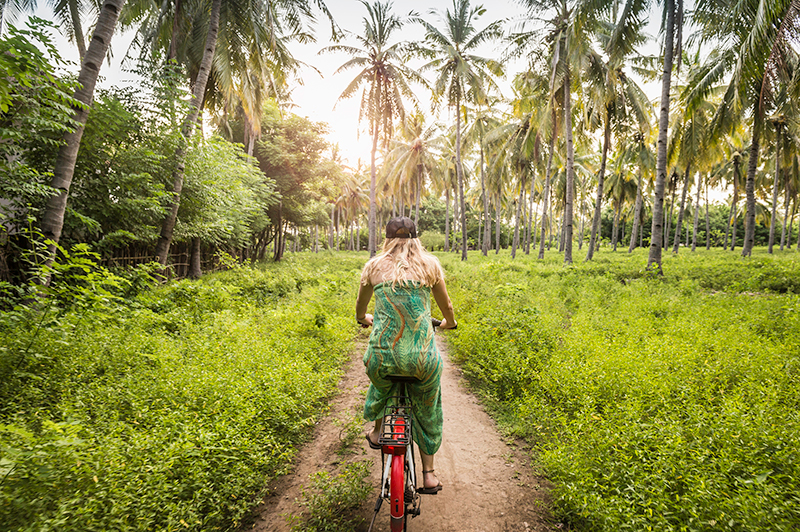 Gili Meno may be the least developed of the Gilis, but it's perfect for your castaway dreams. (Image: Getty)
Gili Meno may be the least developed of the Gilis, but it's perfect for your castaway dreams. (Image: Getty)3. The Gili Islands
A short boat ride from Senggigi on Lombok’s west coast are the Gilis: three paradisiacal desert islands surrounded by coral gardens and neon-blue seas, each with a unique character. Gili Trawangan is the largest and most developed of the three with an ever-growing range of boutique resorts. It’s also centre of nightlife on the Gilis, with weekly beach raves and rows of bars that trade until dawn. Closer to the mainland, Gili Air has a low-key atmosphere, but all the amenities holidaymakers need – the island recently got its first ATM. Accommodation is likewise low-key, mostly bungalow-style with verandas overlooking the sea. The third and least developed in the triumvirate is Gili Meno, a castaway-like sandbank prized among scuba divers for the Gili Meno Wall. The most colourful of all 17 dive sites in the Gilis, it reaches a depth of 22m down and is a magnet for marine turtles and moray eels.
Why visit now? There are now dedicated free-diving centres on all three Gili islands with courses catering specifically to beginners.
Feature image: Ubud region in Bali (Image: Getty)


